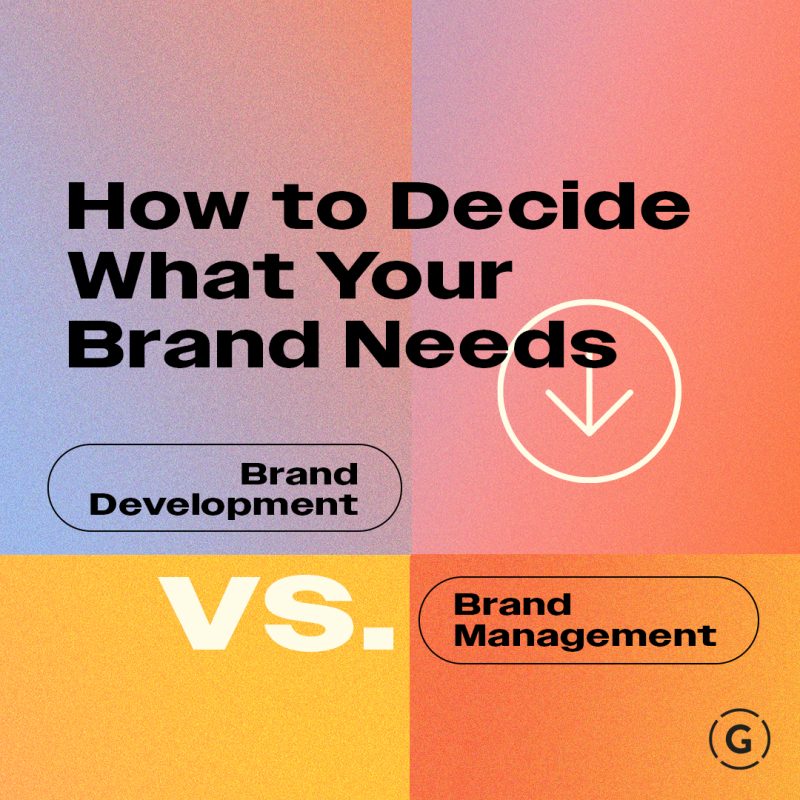Table of Contents
Brand development is an important exercise for new brands, but even well-known, long-established brands such as CocaCola and Pepsi occasionally update their logo, color palette, and brand messaging. So how is a marketer to know when is the right time to update or redevelop their brand, or when to manage the brand as it currently exists? And what does brand management even mean?
Here we will unpack the principles of brand management to understand when brand development is necessary, and when it isn’t.
Start with a Brand Audit
Before all else, we must understand what we have. You cannot identify whether or not it is appropriate to invest in all new brand development, or even a brand refresh, without first understanding your brand’s value and the opportunities for improvement.
I like to think of a brand audit in terms of five key elements:
- Brand Awareness
- Brand Perception
- Brand Purchase Behaviors
- Brand Preferences
- Brand Promotion
Brand Awareness
Your brand awareness is the extent to which audiences are aware of your brand as part of the competitive set. This includes awareness of your individual branded products or services as well as awareness of the parent brand. Brand awareness is viewed along two dimensions: Brand recall, which measures consumers’ ability to remember your brand without being prompted, and brand recognition, which is the ability for consumers to recognize your brand when being offered a choice from a list of others in the same category.
Brand recall and brand recognition can be measured by conducting surveys with audiences that are aligned with your brand’s demographic, psychographic and behavioral profiles. These measurements should be taken over time, especially before and after promotional campaigns, to keep a pulse on brand awareness and to understand the effectiveness of your marketing efforts.
Brand Perception
In addition to understanding audiences’ brand awareness, it is important to know their perceptions of your brand. What do current and potential customers believe you stand for? How do they perceive your product or service reliability and quality? Do customers perceive your brand as providing good economic value? What about elite status, or a high-end experience?
Similar to brand awareness, brand perception can also be measured with surveys. But, as this is a deeper layer of brand engagement, there are additional tools which can help you identify brand perception, including sentiment tracking on social media, and actual customer feedback. To make this data actionable, any tools you deploy to measure brand perceptions must also be used to gauge the perceptions of your competitive set.
Brand Purchase Behaviors
Purchase behavior looks beyond audiences’ opinions by measuring how consumers actually interact with your brand. Here you evaluate what motivates consumers to make a purchase, why they chose a particular brand (whether it’s yours or a competitor’s) and how well your brand meets their expectations.
Fortunately, we have a great deal more data to draw on when evaluating purchase behaviors, including actual transaction and customer onboarding data (particularly the ‘how did you hear about us’ questions asked in the onboarding process), customers’ loyalty and lifetime value, and customer service feedback. Your customer database should serve as a wealth of information here, but more can also be gleaned from surveys and focus groups.
Brand Preferences
Once consumers have experience with your brand, whether they’ve purchased your product or not, you will be able to begin measuring their brand preferences. Which brand consistently meets or beats your audiences’ expectations? Are they willing to pay a premium for that brand? Why?
These questions and more can be answered by evaluating online purchase behavior, customer turnover, customer service feedback, competitive market presence (e.g. earnings reports, press releases), social media sentiment tracking, focus groups or 1:1 interviews, and of course, surveys. The key here is to fully understand why customers choose you (or why they don’t), whether or not they are likely to switch after they’ve made that choice, and why.
Brand Promotion
It is a well-known marketing principle that it costs five times more to acquire a new customer than it costs to keep an existing customer or client. An exception to this rule is customers who come in by a referral from your existing clients. In today’s world of social-media-only brands and AI-generated online reviews, consumers are perhaps relying more than ever on trusted referrals from people they know. According to reputation.com, word-of-mouth drives as much as 50% of purchase decisions, with 76% of Gen X and Millennial consumers relying on recommendations from people they know more than they rely on branded content.
The primary key performance indicator of a customer’s likelihood to recommend your brand is called the Net Promoter Score (NPS). The NPS is calculated by surveying a statistically relevant sample of customers and then calculating the difference between your brand’s detractors vs. promoters. To help gauge your brand health, you should be measuring your NPS annually and comparing it against your prior scores as well as the current NPS benchmark for your industry.
Deciding What to do After the Brand Audit
After you’ve quantified your brand’s strengths, weaknesses and opportunities you’ll be able to decide whether you are in need of a full brand development exercise to rebrand your organization, or if you are well-poised to move forward with purposeful brand management with a slight refresh.
Brand Development
Brand is so much more than a look and feel. A brand identity is the cornerstone of the customer experience. Sometimes audiences don’t sense the brand image we want to convey. This can happen for many reasons including evolving business strategies and new product launches, or differences between marketing strategies vs. operational realities.
If your brand audit uncovers serious concerns or a vast disconnect between how audiences perceive your brand vs. how you’d like to be perceived, it’s best to revisit your brand strategy and begin the process of brand development. An experienced brand strategist will walk you through the process of identifying your real brand promise (current and aspirational), and develop a comprehensive brand strategy to help you communicate your brand story to all audiences.
Brand Management
When audiences’ perceptions of your brand are aligned to your brand identity, you are free to turn your attention to brand management. In this case, the focus is on reinforcing brand perceptions while building greater brand awareness, driving brand preference and increasing brand advocacy.
Just as brand development takes a focused commitment to understanding and addressing audiences’ needs, brand management requires a purposeful approach. Building brand awareness requires achieving a balance between performance marketing and brand marketing. Rather than focus too much on CTAs, you must tell your brand story in an authentic manner that connects with audiences emotionally on all upper funnel marketing platforms.
That same emotive storytelling should carry through to lower parts of the marketing funnel in order to drive and/or reinforce brand preference at the point of purchase decision, and should also be used to build brand advocacy within your customer base. Marketers often focus on direct response, deal-oriented advertising, but when this is balanced with brand advertising audiences feel good about the brand they see and interact with. This creates a greater propensity to trust, buy, pay a premium, and recommend your brands’ products and services.
Since 2008, Gigasavvy has helped brands identify opportunities and connect to their audiences with impactful brand strategies. Contact us to get help developing or managing your brand.



